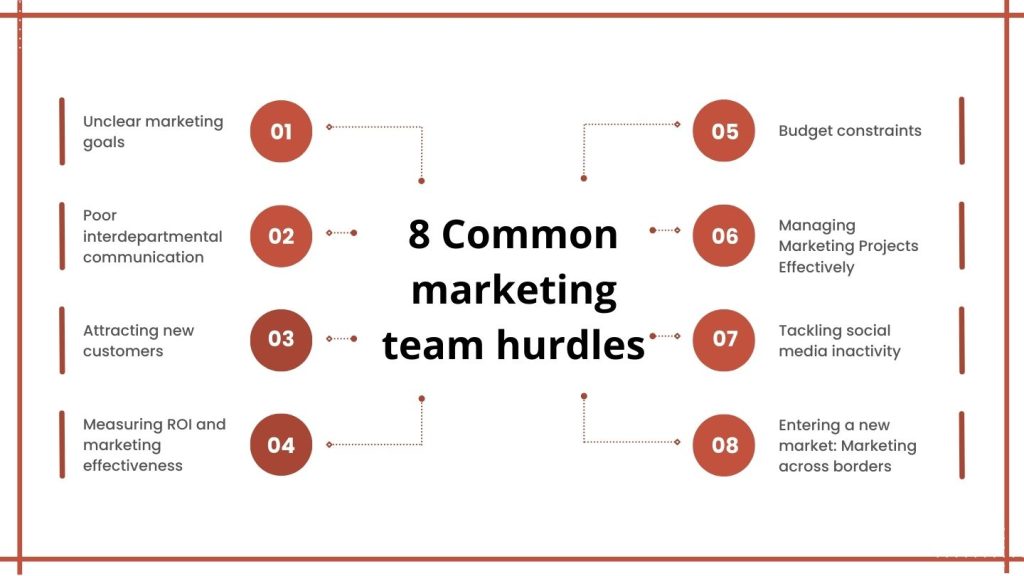Introduction
Marketing is a broad concept that includes advertising, public relations, promotions, social media management, and much more. Along with these, many hurdles like budget limitations, adapting new marketing changes, ROI measurement, less social media engagement, etc., can keep your marketing efforts from effectively reaching your goals. With rising customer expectations and technological advancements, markets today must balance staying relevant while mastering data-driven strategies, all while managing budget constraints, social media engagement, and ROI measurements,
In this blog, we will explore the eight most common issues faced by marketing teams and discuss potential solutions for addressing them.
Let’s navigate the complexities of the marketing team and their effective solutions:
Enhance your knowledge: 7 Absolute bad management habits at work
8 Common marketing team hurdles and ways to overcome them
Now, let’s get introduced to those eight hurdles and know the best practices to conquer them.

1. Unclear marketing goals
When marketing objectives are vague and not aligned with the company’s overall strategy, it leads to inefficiency, decreased productivity, and a decline in the company’s digital footprint. It weakens the competitive position of the business niche.
To deal with it, you have to maintain transparency between your vision and your marketing team. Here are some strategies that you can follow:
- Establish SMART goals: Make each marketing objective Specific, Measurable, Achievable, Relevant, and Time-bound. This helps maintain clarity and track progress.
- Align with business strategy: Ensure marketing objectives are aligned with the general organizational strategy to maximize impact.
- Conduct regular reviews: Break long-term goals into smaller milestones and evaluate them frequently. This allows you to adapt strategies based on new data and market trends.
2. Poor interdepartmental communication
Working in silos and not cooperating with other departments is one of the major setbacks for the marketing team. It affects decision-making progress and hinders output that is inconsistent with the company’s vision.
When the marketing team doesn’t communicate with other departments, it causes inefficiency and undermines the company’s online presence. Here are some strategies to overcome:
- Foster a culture of open communication and collaboration: Provide your team with an open platform to share their ideas with other departments and to ask questions. In order for the team to fully engage, all members should feel free to express their thoughts towards a certain project.
- Break down silos and promote cross-functional teams: Develop multi-tactical organizations where people from different departments work together towards the accomplishment of their goals and objectives. This will assist in the demсіon of isolated structures and the development of a teamwork culture.
- Encourage social interactions and team-building activities: Sponsor social activities or fun events that can foster acquaintance with other employees, hence encouraging cross-department relationships.
3. Attracting new customers
Customer acquisition is an ongoing challenge for marketing departments as the process of attracting new customers never ends. Customer needs shift frequently, adding complexity to targeting efforts. To tackle issues like these, here are some effective strategies:
- Targeted marketing campaigns: The target consumers should be segmented into smaller groups within the numerous classifications, taking into consideration demography and psychographic attributes. Focus campaigns on specific audience needs and pain points to increase engagement.
- Content marketing and SEO: Publish relevant, high-quality content that solves customer problems. Optimize content for search engines to boost organic traffic and visibility.
- Customer experience and loyalty: Loyal customers should be encouraged through various incentives such as reward programs and exclusive offers to keep customers engaged. Satisfied customers are more likely to refer to others and remain loyal.
4. Measuring ROI and marketing effectiveness
Tracking the return on investment (ROI) from marketing activities is critical, but it can be complex. Teams often struggle to measure the effectiveness of campaigns across multiple platforms, especially when digital marketing spans paid ads, social media, and email marketing. The workable solutions can be:
- Implement analytics tools: Track performance across channels by using several platforms like Google Analytics, HubSpot, or social media analytics tools.
- Define clear KPIs: Identify key performance indicators (KPIs) that are aligned with your objectives, such as conversion rates, cost-per-acquisition, or customer lifetime value.
- Use A/B testing: Research and experiment with different strategies that may evaluate the result. Analyze the results to find out what works best and what needs to be adjusted so you can change the plan next time.
Also read: 7 Steps to Lead Diverse Teams Effectively in The Workplace
5. Budget constraints
Budget constraints keep the marketing team from effectively deploying campaigns, reaching out to a larger audience, and trying out new approaches. This challenge can occur for many reasons, including economic issues, competition, and internal objectives.
Strategies to overcome this issue:
- Prioritize high-impact channels: Determine & research which marketing activities deliver the best ROI and give you the most return on investment you seek. Focus more on the campaigns that yield the highest return on investment (ROI) rates.
- Repurpose content: Maximize the use of existing content by repackaging it into different formats, such as turning blog posts into videos or social media posts.
- Measure and optimize: Control the results generated within your marketing streams and critically evaluate to find out what can be optimized in terms of cost efficiency.
6. Managing Marketing Projects Effectively
Marketing professionals sometimes face difficulties in project management since marketing goals are dynamic. Marketing projects usually require contributions from clients, the sales team, and other departments in the organization. Managing their requirements and ensuring everyone is on the same page can be daunting for marketing project management.
This means that goals and priorities can shift quickly, making it difficult to maintain a strict project timeline. Here are some tactics to tackle this challenge:
- Use of project management tool: Adopting a project management and team collaboration tool to assign task assignments, delegate work, and monitor overall project progress. It also helps manage and distribute your entire task while ensuring all deadlines are met.
- Agile methodology: Adapting Agile methodology as priorities evolve. This involves the process of dividing tasks into several deliverables in small segments, known as sprints. This helps reviewing progress into smaller deliverables that provides flexibility since teams can adapt to changes easily.
- Effective communication: Regular communication is vital and should be unambiguous. This entails daily, weekly, and monthly meetings, status reports, feedback, and communication systems. Communication can also be eased with project management tools so that everything is on track and synchronized.
7. Tackling social media inactivity
Social media inactivity usually limits a marketing team’s ability to communicate effectively with the target market. Even established brands struggle if they fail to stay connected with their online audience. Solutions for a Strong Social Media Presence:
- Understand Your Audience Deeply: Gain insights about your audience’s interests, challenges, and preferred content types using surveys, social media monitoring tools, and analysis.
- Optimize content strategy: Create content that is engaging, well-researched, and fits the needs and wants of your target demographic. You could use storytelling, humor, or any other educational presentation to draw the audience’s attention. Incorporate images, videos, and infographics to enhance your content visibility. Experiment with the type of content you post for your feeds to find out which is more liked by people.
- Build community engagement: Always answer the comments, questions, and messages that your audience posts on your social media page. Prove that you care about your target audience’s reaction and are interested in their opinion. Engage your audience to share their stories with your brand through your UGC campaigns.
Read more: 7 Biggest causes of workplace conflict (and How to resolve them)
8. Entering a new market: Marketing across borders
Differences in culture, competition, and regulations raise this challenge within your marketing team. Every culture possesses its norms, expectations, and attitudes, which may affect marketing strategies, thus making it a critical component of the marketing environment. Strategies to ease market entry:
- Cultural nuances: It is crucial to study the target culture as it applies to the target consumer. This means features such as language, etiquette, and customs within the given society. Come up with marketing strategies and messages that are in harmony with the culture of the targeting community.
- Competitive landscape analysis: Conduct a SWOT analysis on local and global competitors operating in the market. Understand what’s their strength & weaknesses, their competitive edge, and USP. By analyzing these data, you create a customized value proposition to set you apart from your competitors.
- Regulatory compliance and legal considerations: Ensure you know the new market’s legal and regulatory framework. This includes advertising, consumer protection, and data privacy laws. Be ready to modify your marketing strategies depending on future changes.
Summarizing
The marketing team faces tremendous difficulties that affect the efficiency of the business and its sales. Such challenges include ambiguity of goals set, poor interdepartmental cooperation, challenges measuring ROI on communication programs, and inadequate funding, which can adversely affect companies’ progress.
By tackling these challenges with the above strategies, marketing departments can improve their ability to market the brands, generate leads, and impact the business goals.

















No Comments